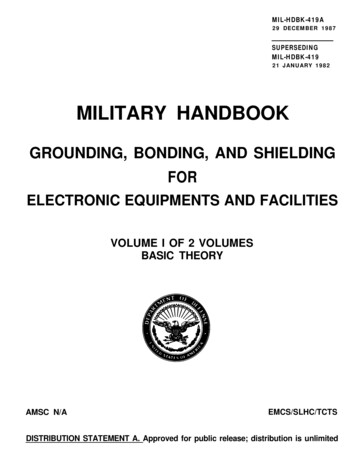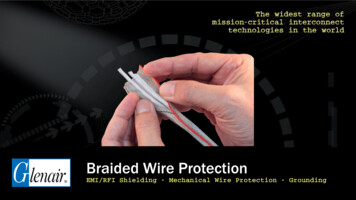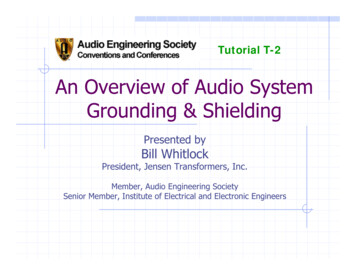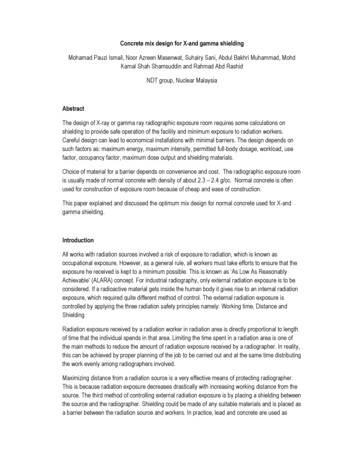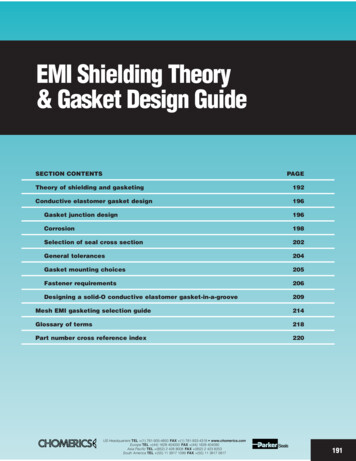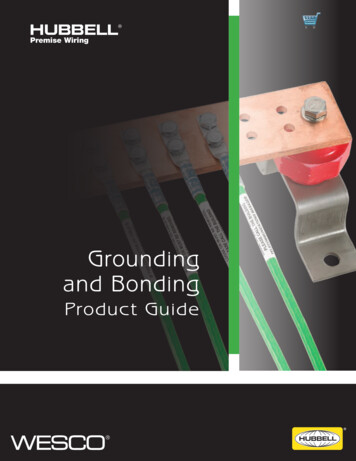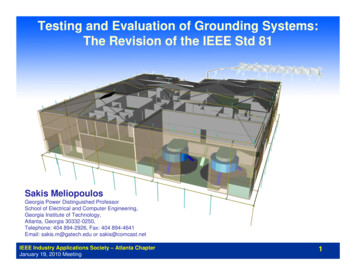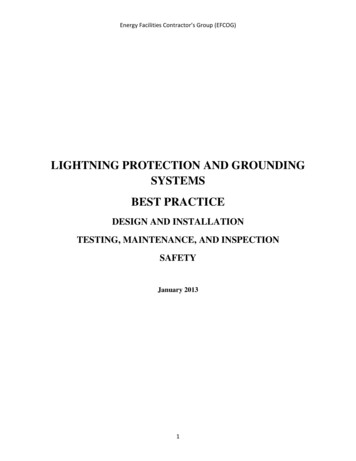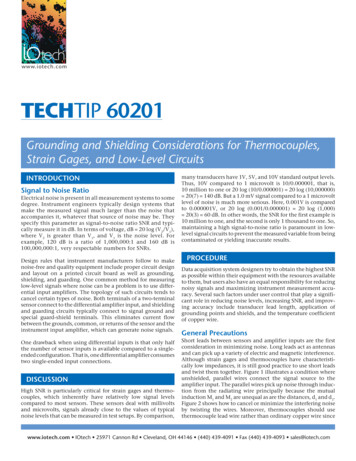
Transcription
www.iotech.comTECHTIP 60201Grounding and Shielding Considerations for Thermocouples,Strain Gages, and Low-Level CircuitsINTRODUCTIONSignal to Noise RatioElectrical noise is present in all measurement systems to somedegree. Instrument engineers typically design systems thatmake the measured signal much larger than the noise thataccompanies it, whatever that source of noise may be. Theyspecify this parameter as signal-to-noise ratio SNR and typically measure it in dB. In terms of voltage, dB 20 log (V2/V1),where V2 is greater than V1, and V1 is the noise level. Forexample, 120 dB is a ratio of 1,000,000:1 and 160 dB is100,000,000:1, very respectable numbers for SNRs.Design rules that instrument manufacturers follow to makenoise-free and quality equipment include proper circuit designand layout on a printed circuit board as well as grounding,shielding, and guarding. One common method for measuringlow-level signals where noise can be a problem is to use differential input amplifiers. The topology of such circuits tends tocancel certain types of noise. Both terminals of a two-terminalsensor connect to the differential amplifier input, and shieldingand guarding circuits typically connect to signal ground andspecial guard-shield terminals. This eliminates current flowbetween the grounds, common, or returns of the sensor and theinstrument input amplifier, which can generate noise signals.One drawback when using differential inputs is that only halfthe number of sensor inputs is available compared to a singleended configuration. That is, one differential amplifier consumestwo single-ended input connections.DISCUSSIONHigh SNR is particularly critical for strain gages and thermocouples, which inherently have relatively low signal levelscompared to most sensors. These sensors deal with millivoltsand microvolts, signals already close to the values of typicalnoise levels that can be measured in test setups. By comparison,many transducers have 1V, 5V, and 10V standard output levels.Thus, 10V compared to 1 microvolt is 10/0.000001, that is,10 million to one or 20 log (10/0.000001) 20 log (10,000000) 20(7) 140 dB. But a 1.0 mV signal compared to a 1 microvoltlevel of noise is much more serious. Here, 0.001V is comparedto 0.000001V, or 20 log (0.001/0.000001) 20 log (1,000) 20(3) 60 dB. In other words, the SNR for the first example is10 million to one, and the second is only 1 thousand to one. So,maintaining a high signal-to-noise ratio is paramount in lowlevel signal circuits to prevent the measured variable from beingcontaminated or yielding inaccurate results.PROCEDUREData acquisition system designers try to obtain the highest SNRas possible within their equipment with the resources availableto them, but users also have an equal responsibility for reducingnoisy signals and maximizing instrument measurement accuracy. Several such factors under user control that play a significant role in reducing noise levels, increasing SNR, and improving accuracy include transducer lead length, application ofgrounding points and shields, and the temperature coefficientof copper wire.General PrecautionsShort leads between sensors and amplifier inputs are the firstconsideration in minimizing noise. Long leads act as antennasand can pick up a variety of electric and magnetic interference.Although strain gages and thermocouples have characteristically low impedances, it is still good practice to use short leadsand twist them together. Figure 1 illustrates a condition whereunshielded, parallel wires connect the signal source to theamplifier input. The parallel wires pick up noise through induction from the radiating wire principally because the mutualinduction M1 and M2 are unequal as are the distances, d1 and d2.Figure 2 shows how to cancel or minimize the interfering noiseby twisting the wires. Moreover, thermocouples should usethermocouple lead wire rather than ordinary copper wire sincewww.iotech.com IOtech 25971 Cannon Rd Cleveland, OH 44146 (440) 439-4091 Fax (440) 439-4093 sales@iotech.com
TC wire is designed just for this application. In most cases, the special lead wiremay be obtained from the thermocouplemanufacturer or supplier.The second consideration is the groundpoint. Usually, a ground connection is madeat either the amplifier input or preferablythe sensor, but definitely not at both. Whenboth devices are grounded, a small butmeasurable “ground-loop” current can flowbetween them and manifest in an unwantednoise signal at the amplifier input terminals. The best policy is to follow the manufacturers grounding recommendations forits particular instrument and sensor.The circuit in Figure 3 shows a potentialdifference between earth ground #1 andearth ground #2. As a result, two groundloop paths are generated when the shield,sensor return, and sensor shield are allgrounded to earth ground #1, and the otherend of the shield, the sensor return, thecommon amplifier terminal, and amplifierchassis are connected to earth ground #2.One circulating current runs through theshield conductor, and the other runsthrough the signal return (or common)wire. Figure 4 shows that the ground loopcurrent through the shield is eliminatedwhen its ground connection is removedfrom earth ground #2. Likewise, the loopcurrent in the signal return path is eliminatedwhen the ground connection is removedfrom terminal 2 of the amplifier.In addition, wires shielded with copper,aluminum, and tin can minimize mostelectrical interference, but ferrous materials may be needed to shield wires wherehigh magnetic fields may be present. Copper or aluminum shields alone may notbe effective enough. Moreover, grounding these shields require as much care asother shields to minimize ground loopcurrents that can appear as signals to theamplifier input terminals.Copper wire has a relatively high temperature coefficient of resistance. However, ittends to be neglected when the sensor signals are so large that any changes in impedance due to the wire’s temperature coefficient have negligible effect. But in highimpedance, low-level circuits, or circuitswith long lead wires, the wire resistance byitself or with a change temperature can besignificant and affect the measurements byas much as 10% or more. In many cases,Figure 1: Induced Noise: Parallel WiresIinDistributing wireM1M2d1d2AmplifierIXEinRLSignal sourceGround planeParallel signal wires can pick up noise by induction when the mutual inductances M1 and M2are unequal.Figure 2: Induced Noise: Twisted WiresIinDistributing wireM1M2d1d2AmplifierIXEinRLSignal sourceGround planeTwisted input signal wires tend to bring the values of the mutual inductances M1 and M2closer together and cancel the inductive noise.Figure 3: Multiple Ground-Loop PathsSignal sourceor sensorEffective capacitanceSignal conditioning anddata acquisition systemCable otential differenceEarthground #1Desktop ornotebook computerEarthground #2Ground loop currents are generated when a difference of potential develops between the sensorground and the amplifier ground connections. More than one path exists, as shown in this example.Figure 4: Eliminating Ground-Loop PathsSignal sourceor sensorSignal conditioning anddata acquisition systemEffective shielded areaC1AmpESignalprocessing2ZCable shieldNo path for currentto circulatePotential differenceEarthground #1Earthground #2Desktop ornotebook computerRemoving the ground connection at the amplifier input eliminates one ground loop path, andthe other by removing the ground connection at the amplifier input terminal #2.2www.iotech.com IOtech, Inc. 25971 Cannon Rd Cleveland, OH 44146 (440) 439-4091 Fax (440) 439-4093 sales@iotech.com
however, wire resistance effects can be cancelled by using a fourwire system where one pair is the “excite” wires, and the otherpair is the “sense” wires, such as used in bridge circuits. (SeeReference 1, page 85)1.not use the shield connection at the amplifier end. (Remember,the shield must not be grounded at both ends.)Strain GagesStrain gages (and frequently, thermocouples) are fastened mechanically and sometimes electrically to the device under test.This arrangement can set up a path for ground loop currents andcommon-mode voltage noise signals. Use non-inductive typesof strain gages and ground the shields only at the sensor end.Use the differential input terminals of the data acquisitionsystem and make certain that neither terminal is inadvertentlygrounded through an inconspicuous “sneak circuit.”ThermocouplesThermocouples should be electrically isolated from the deviceunder test where possible to avoid ground-loop currents, common-mode voltage problems, and induced voltage or current.However, most thermocouple instrument amplifiers provideungrounded temperature reference input terminals mountedon isothermal blocks that help minimize such noise problems.For example, Figure 5 shows the temperature compensatedisothermal block and input connections to the IOtech DBK81 series of thermocouple amplifiers.Figure 6 is an example of a situation where a differential amplifierinput is selected but the cable shield is connected to the amplifiercommon. The common-mode voltage Ecm appears between signalground and system ground. The distributed capacitance in thecable shield shunts the amplifier input impedance to ground andsets up a noise current (Icm) path through the signal source.Removing the connection from the shield to system ground at theamplifier input and connecting the shield to the signal ground atWhen thermocouple wire leads must be shielded, use the shieldconnection provided at the input to the amplifier, and do notconnect the other end of the shield (at the device under test) toa ground. However, when the thermocouple must be grounded,use the same ground terminal to connect to the shield and doFigure 5: Thermocouple Input AmplifierChannels2 thru 7Channel 1 (of 7)OTC BIASInputprotection Inst.amp–Diff/CMLPFCH 1BufferOutputchannelselectheader(JP1)8 to 1MUXOTC BIASCH 73IsothermalinterfaceChannel Select LinesCJCCH 1 HLP1ThermistorCH 7 HL16To inputprotectionThe IOtech DBK81 series of thermocouple input amplifiers contain an isothermal,temperature-compensated block to eliminate inadvertent thermocouple effects atthe terminals. It also contains differential input amplifiers and shield connectionsto minimize noise problems.R to VconverterSHIELDFigure 6: Incorrect Grounds for Differential AmplifiersSignal sourceor sensorDistributedcapacitanceCable shieldZDifferential amplifier ndThe distributed capacitance in the cableshield shunts the amplifier’s inputimpedance to ground, develops a commonmode voltage, Ecm, and lets noise currentsflow through the signal source.Common-mode voltageIcmEcmSystemgroundDesktop ornotebook computer1. For more detailed circuit descriptions and applications, refer to the publication, Signal Conditioning and PC-Based Data Acquisition Handbook, published byIOtech, Inc., and available from IOtech at www.iotech.com.3www.iotech.com IOtech, Inc. 25971 Cannon Rd Cleveland, OH 44146 (440) 439-4091 Fax (440) 439-4093 sales@iotech.com
Occasionally, some of the above precautions cannot be followedimplicitly. When in doubt, the best procedure is to use thedifferential input terminals to the data acquisition systemrather than single-ended inputs, and connect the shield to thesensor or signal source common terminal.the sensor as shown in Figure 7 reduces the effect of cable capacitance and prevents common mode current, Icm, from flowingthrough the signal source. In this way, the systems common moderejection ratio is greatly improved.Strain gages and other bridge circuits used with strain gagemodules such as the IOtech WBK16 are not usually grounded.The WBK16 uses differential input amplifiers with excitationvoltage supplied by isolated and current-limited power suppliesto help minimize noise problems. However, when strain gagewires need shielding, use quality cable, such as the CA-177 staingage cable, and connect the shield to the DB9 metal shell. Theshell does not return to common ground, therefore commonmode voltage and current cannot interfere with the measuredsignal. Also, use twisted pair cable with paired leads for signalinput, excitation output, and remote sense input. See Figure 8,the block functional diagram of the WBK16, for an exampleshowing connections to a full-bridge strain gage.Other ConsiderationsThe impedance of a signal source should be much lower than theamplifier input impedance to ensure high system accuracy. As thesignal source impedance approaches zero, so does the amplitude ofthe noise signal to the amplifier. However, in most cases, users neednot concern themselves with these issues. Most data acquisitionsystem manufacturers have considered such loading problems andoffer specific signal conditioning amplifiers that match transducers and special circuits. For example, signal conditioners are available for thermocouples and strain gages that offer the properimpedance matching and temperature compensation.Figure 7: Correct Grounds for Differential AmplifiersSignal sourceor sensorDifferential amplifier inputCable shieldTransposing the ground connection fromthe amplifier end to the signal sourceend reduces the effect of the cablecapacitance and prevents common-modecurrent from flowing through the signalsource. The common-mode rejection isgreatly undCommon-mode voltageEcmDesktop ornotebook computerSystemgroundFigure 8: Strain Gage Input AmplifierChannel 1 (of 8)User strain gageGain x1, 10,Gain 100, 1000 x1 to 20DB9( ) EXC( ) SENSER1R2Bridge completionandshunt cal networkR4R3Progammableexcitationregulator withremote sense(–) SENSE(–) EXCOutputselectionLPFaPGIAPGAProgammableoffset voltagereferenceMUXf4-polelow-pass filtersCH 8CH 7CH 6CH 5CH 4CH 3CH 2InverterampChannelselectionMUXCH 1MUXTh
Grounding and Shielding Considerations for Thermocouples, Strain Gages, and Low-Level Circuits www.iotech.com IOtech 25971 Cannon Rd Cleveland, OH 44146 (440) 439-4091 Fax (440) 439-4093 sales@iotech.com www.iotech.com INTRODUCTION Signal to Noise Ratio Electrical noise is present in all measurement systems to some degree. Instrument engineers typically design systems .
